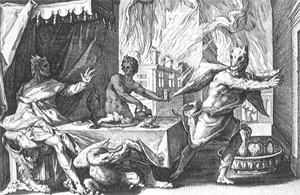 Why Are Werewolves So Scary?FOR IMMEDIATE RELEASE Trent University Researcher Explores Ancient Werewolf Depictions to Understand their Power Thursday, October 30, 2008, Peterborough
Through his research, Mr. Newman-Stille found that werewolves and other transitory creatures were often viewed as monstrous because they show humanity mixed with the animalistic. “What is frightening to us is that idea that there IS some humanity to the werewolf; that it is a blending of the two states and that it may symbolize a beastial nature in all human beings,” Mr. Newman-Stille explained. “Werewolves are the perfect symbol for liminality – occupying a transitory state and not fixed as either human or wolf but able to fluctuate between the two states,” he said. “The classical werewolf is somewhat different from the modern conception of it. The modern, popular image of the werewolf is a person who turns into a hybrid of human and wolf characteristics – generally a person with fur, claws, and fangs.” He went on to explain that in classical literature, the werewolf usually would turn from a human being completely into a wolf. Generally the classical werewolf becomes a wolf with the aid of a spell (either performed on oneself or by another), as an act by a god, or through some form of ritual action. According to Mr. Newman-Stille, lycanthropy, or werewolfism, derives its name from the mythical Roman character Lycaon, king of Arcadia who murdered a man and tried to give the flesh of this man as an offering to Zeus. Zeus recognized it for what it was and destroyed Lycaon’s house. Lycaon tried to flee but when he was out in the fields he continued to be bloodthirsty and ripped apart sheep, gradually becoming more and more hairy until he was only a wolf. “The human mind naturally categorizes everything, and anything that fits between these established categories is considered potentially dangerous,” said Mr. Newman-Stille. “Rituals are a society’s way of making a potentially confusing and religiously dangerous situation into a sacred one. Many liminal symbols have the potential to be viewed as either sacred or profane.” Mr. Newman-Still noted that being liminal creatures, werewolves embodied the suspicion and fears of ancient civilizations, a characterization that only became less monstrous when the werewolves were associated with purification rituals in these stories. -30- For further information, please contact Derek Newman-Stille, senior tutor, Trent University, please email him at dereknewmanst@trentu.ca (preferred) or call (705) 748-1011, ext. 7769 or 7657. |

































 Derek Newman-Stille, a senior tutor at Trent University and M.A. graduate in Anthropology, says the Greeks and Romans portrayed the werewolf in their literature as frightening because it is a liminal symbol - being between one state and another.
Derek Newman-Stille, a senior tutor at Trent University and M.A. graduate in Anthropology, says the Greeks and Romans portrayed the werewolf in their literature as frightening because it is a liminal symbol - being between one state and another.